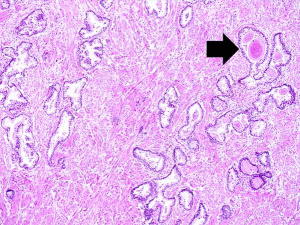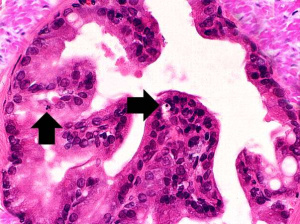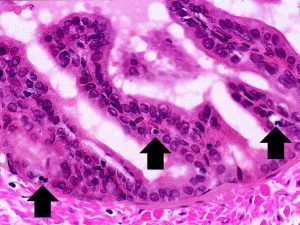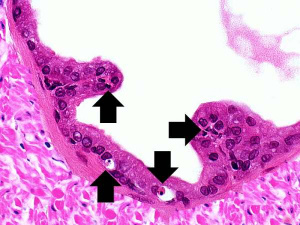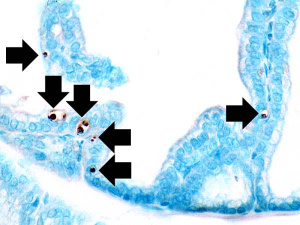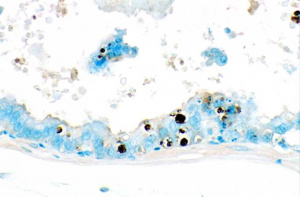IPLab:Lab 1:Prostate
Contents
Clinical Summary[edit]
This 68-year-old man with a 7-year history of prostatic carcinoma developed metastases to the bones of the pelvis and lumbar spine which produced significant pain and discomfort. He was treated with androgen deprivation therapy to slow the growth of the tumor and decrease the size of the tumor metastases in order to help relieve his bone pain. The androgen deprivation therapy did reduce his pain; however, two months after starting the androgen deprivation therapy, the patient experienced an acute myocardial infarction and died suddenly.
Autopsy Findings[edit]
At autopsy the patient's myocardial infarction was found to have resulted from the thrombotic occlusion of the proximal left anterior descending coronary artery. There was evidence of cancer in the peripheral region of the prostate gland and there were metastases present in the pelvis and lumbar spine. The patient also had moderate testicular atrophy.
Images[edit]
Study Questions[edit]
Additional Resources[edit]
Reference[edit]
- eMedicine Medical Library: Metastatic and Advanced Prostate Cancer
- Merck Manual: Prostate Cancer
- National Cancer Institute: Prostate Cancer
- British Columbia Cancer Agency: Prostate Cancer
Journal Articles[edit]
- Denmeade SR, Isaacs JT. Programmed cell death (apoptosis) and cancer chemotherapy. Cancer Control 1996 Jul;3(4):303-309.
- Brookes PS, Salinas EP, Darley-Usmar K, Eiserich JP, Freeman BA, Darley-Usmar VM, Anderson PG. Concentration-dependent effects of nitric oxide on mitochondrial permeability transition and cytochrome c release. J Biol Chem 2000 Jul 7;275(27):20474-9.
Images[edit]
| |||||
Prostatic carcinoma is a highly metastatic form of cancer.
Back pain resulting from vertebral metastases of prostatic carcinoma is not uncommonly the presenting symptom which leads to the discovery of the carcinoma. Pain occurs late in the metastatic process and is an indicator of a poor outlook for a patient.
Myocardial infarction is necrosis of myocardial tissue which occurs as a result of a deprivation of blood supply, and thus oxygen, to the heart tissue. Blockage of blood supply to the myocardium is caused by occlusion of a coronary artery.
An occlusion is a blockage.
Most commonly, prostatic carcinoma arises in the peripheral region of the gland.
Corpora amylacea are small hyaline masses of degenerated cells and inspissated secretions. They are so named because they resemble (but are categorically not) amyloid deposits.
